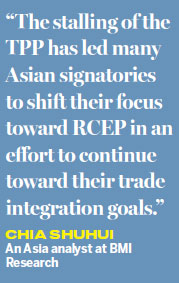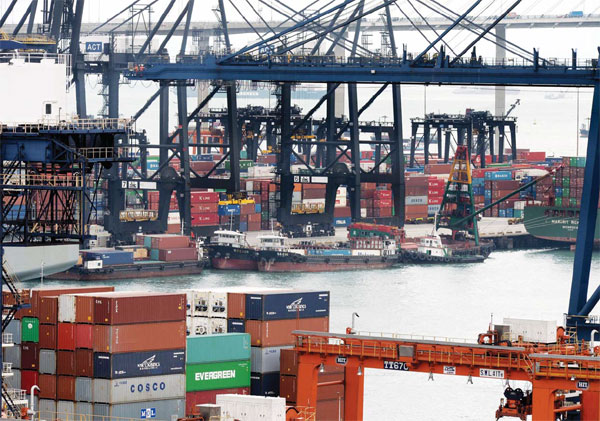Trade remains the basic fabric of Asia

Recent threat of protectionism adds new urgency to agreements in a region that has always thrived on cross-border commerce
Despite the rise of protectionist sentiment in some Western countries, Asia continues to push for lower barriers and easier and cheaper cross-border trade.
After all, most Asian economies were built on trade and depend on it for growth.
In the 1960s and 70s, Japan grew rich by manufacturing and exporting high-quality, high-value-added goods - from electronics to cars. South Korea followed suit some time later, as did Hong Kong, Taiwan and Singapore, collectively known as the four Asian tigers.
| CONTAINERS AND CRANES in Hong Kong. The city's massive port operations act as an important conduit for trade with the Chinese mainland. Provided to China Daily |
The Chinese mainland used trade to build its massive manufacturing capacity and emerge as the factory of the world. Hong Kong developed into a financial hub but also focused on its massive port, through which much of the mainland trade flows. Singapore operates as a similar gateway for Southeast Asia.
Now, Vietnam and Cambodia are emerging as lower-cost manufacturing hubs. Indonesia depends in large part on commodity exports to support its economy. India exports manpower, inexpensive drugs and services.
Trade is built into the fabric of Asia, a region that has grown rapidly thanks to the push for greater globalization over the last two decades.
"ASEAN has done well," says Jayant Menon, chief economist at the Asian Development Bank, referring to the 10-member Association of Southeast Asian Nations. "Countries like India are still growing very strongly. It's not a huge trading country but it's strong domestically. China is still growing strongly.
"ASEAN is still doing well in the region. Trade is an important factor."
But it's "not the only factor", he said.
As trade with Europe and North America sags due to slower growth and protectionism, Asian economies are looking to boost regional trade. This gives urgency to the development of regional trade agreements, the largest and most comprehensive of which is the ASEAN-led Regional Comprehensive Economic Partnership, or RCEP.
The RCEP covers ASEAN as well as China, Japan, South Korea, India, Australia and New Zealand - the group generally known as ASEAN+6.
"RCEP is more traditional in terms of its content," Menon saw. "The fact that it has been delayed is a good sign. They are trying to come up with something that contains real reforms. They are working hard on trying to create regulatory convergence - harmonization of rules across countries.
"This is going to be the key contribution in terms of making it easier for the regional bloc."
Markets in North America and Europe are likely to remain attractive and the source of much demand for Asian-made products for the foreseeable future. But Asian countries are increasingly looking to boost domestic consumption through manufacturing.

China, for example, has been aiming for years to increase the proportion of GDP that domestic consumption accounts for. In 2015, domestic consumption made up around 37 percent of GDP, according to the World Bank, compared with 57 percent in Japan and 68 percent in the United States. In Indonesia, domestic consumers account for 55 percent of the economy, but they make up just 36 percent in Singapore.
Most countries are trying to boost their reliance on domestic industries and domestic consumption for growth, with some success.
In 2016, domestic consumption accounted for two-thirds of China's GDP growth. Less than a year earlier it was the single largest contributor to the country's economic expansion. From 2012 to 2014, consumption accounted for just half of growth.
As domestic consumption grows throughout the region, trading among RCEP countries is likely to expand. The 16 countries in the group account for about a quarter of global GDP, more than $22 trillion in economic activity, as well as housing almost half the world's population.
RCEP has taken on added urgency since United States President Donald Trump unceremoniously announced that the US was withdrawing from the Trans-Pacific Partnership agreement it had proposed and fought for.
"The stalling of the TPP has led many Asian signatories to shift their focus toward RCEP in an effort to continue toward their trade integration goals," says Chia Shuhui, an Asia analyst at BMI Research.
"RCEP was launched in November 2012 with the aim of establishing deeper economic cooperation among the 10 ASEAN members and its six dialogue partners by streamlining existing trade agreements.
"Despite its differences with the TPP, we believe that the successful negotiation of RCEP will be positive for trade integration in Asia," Chia says, adding that because trade negotiations are generally kept confidential, "it is difficult to fully determine what the final agreement will look like".
Chia says that although the RCEP aims to streamline existing trade agreements, it is likely to lead to a considerable lowering of tariff barriers, as well as the simplification of rules of origin.
"Given the sheer size of the agreement and heavy participation of developing countries, we do not expect it to significantly lower nontariff barriers or impose strong environmental standards like the TPP," Chia says.
The RCEP has emerged as the best candidate to facilitate large-scale trade liberalization in the region and, perhaps, give global trade something of a boost. It covers goods, services and investment across its participating economies.
In a note, HSBC suggested the RCEP is a good complement to the China-led Belt and Road Initiative, with a significant amount of overlap between the two. The Belt and Road aims to improve connectivity through large-scale trade and infrastructure projects in countries along the ancient Silk Road routes.
Deborah Elms, executive director of the Asian Trade Centre, a Singapore-based consultancy, notes that the RCEP's progress has been slow.
"The problem is we have 16 different countries trying to get an agreement that has dozens of chapters in it. It's complicated."
When negotiations are finalized, the RCEP should go a long way toward eliminating some of the trade frictions that exist in the region, such as disagreements between China and India. At the same time, it should further lubricate the mechanics of trade between China and ASEAN, which seem to get smoother with every passing year.
"When you open up, you are opening up dialogues. That is not easy to do," Elms says. "Even though countries did open markets in the ASEAN framework, what they gave each other in ASEAN is not what the 16 countries want to give each other."
Despite its size, the RCEP includes a set of achievable goals that "will deliver benefits across the region", Elms says.
"For example, there will be tariff cuts in the RCEP. If you're lucky enough to have your product sold in 16 countries, tariff cuts are enormous. They make a huge difference. They make things easier for consumers and companies."
For China Daily
(China Daily European Weekly 02/24/2017 page29)
Today's Top News
- Xi calls for promoting volunteer spirit to serve national rejuvenation
- Xi chairs CPC meeting to review report on central discipline inspection
- Reunification will only make Taiwan better
- Outline of Xi's thought on strengthening military published
- Targeted action plan to unleash consumption momentum
- Separatist plans of Lai slammed































